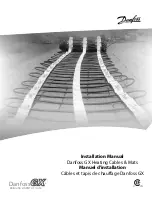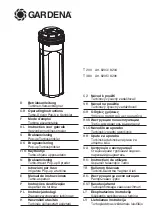
A
IRA
ATH I
NSTALLATION
O
PERATION AND
S
ERVICE
M
ANUAL
SECTION 15: SERVICING INSTRUCTIONS
DANGER
WARNING
Electrical Shock Hazard
Disconnect electric
before service.
More than one
disconnect switch may
be required to
disconnect electric from
heater.
Heater must be
connected to a properly
grounded electrical
source.
Explosion Hazard
Turn off gas supply to
heater before service.
Burn Hazard
Allow heater to cool
before service.
Tubing may still be hot
after operation.
Cut/Pinch Hazard
Wear protective gear
during installation,
operation and service.
Edges are sharp.
Failure to follow these instructions can result in death, electric shock, injury or property damage.
IMPORTANT: Never use the heater as a support for
ladders or other access equipment. Always test for gas
soundness with a suitable detection fluid after completing
any servicing or exchange of gas carrying component.
On completion of any service/fault finding tasks which
require the breaking and remaking of electrical
connections, the checks:- A:Earth Continuity, B:Polarity
and C:Resistance to Earth must then be repeated.
15.1 Annual Procedure
Carry out the following procedure annually. The preferred
time would be immediately before the winter heating
period. If very dirty conditions arise, it may be necessary
to carry out this procedure more often. If the unit takes in
air through an air duct or filter assembly, more frequent
service may be necessary.
15.1.1 Burner and Fan Removal
Isolate the heater from the gas and electrical supplies.
Remove the fan plug from the burner. Unscrew the
securing screws on the burner flange. The burner can
now be removed. Take care not to disturb the gasket on
the flanged burner tube. Unscrew the securing screw on
the fan flange spigot. The fan can now be removed.
15.1.2 Burner and Fan Removal Maintenance
Remove the fan and burner independently to floor level
and clean both items internally using a soft brush and
compressed air, if available. Take care not to damage the
internal parts of the burner. Check fan impeller for
cleanliness and free rotation.
The electrodes are an integral part of the burner. To
check spark gap, remove the securing screws on the
electrode and withdraw it ensuring the gasket is not
damaged. Spark gap on electrode should be
approximately 3 mm.
15.1.3 Tube and Reflector Maintenance
With burner and fan removed, clean the outer surfaces of
the tubes using a brush and wipe the inner surface of the
reflector with a soft damp cloth - use a household
detergent if necessary. Never use abrasive cleaners on
the reflectors. Reassemble the burner and fan in reverse
60 of 73
order. Carry out the Testing Procedure.
15.2 Component Removal
First, isolate the heater from the gas and electrical
supplies. Entry to the burner assembly is gained by
removing the door screws and opening the hinged side
cover. Entry to the combustion chamber is gained by
removing the combustion chamber cover.
15.2.1 Electrode
Figure 36: Burner Cup Position
15.2.2 Burner Head/Injector Jet
When the cover is removed completely, the burner
assembly is exposed. Unscrew the burner cup. Remove
brass injector jet (orifice). Replace in reverse sequence.
15.2.3 Solenoid Valve/Governor
Remove burner head. Remove screws securing the
solenoid/governor body bracket. Withdraw the four wires
between the solenoids. The solenoid/governor and
fittings can now be withdrawn from the compartment. The
solenoid(s) can be removed from the body by unscrewing
central screw. Replace in reverse sequence. Note: Earth
is green/yellow.
Summary of Contents for AIRA ATH Series
Page 66: ...62 of 73 ...
















































